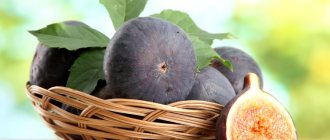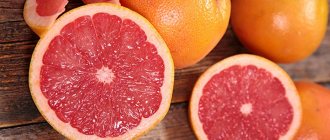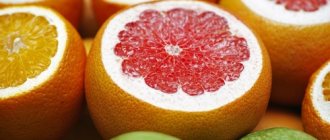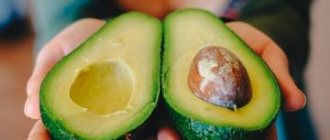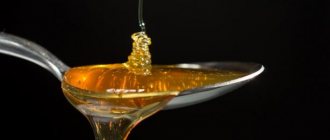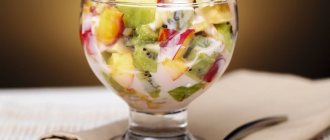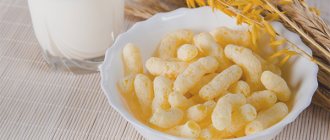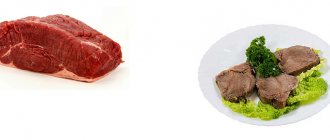Mineola is an artificially bred fruit belonging to the citrus family. Many have seen it in the store and even eaten it, but do not know that it has that name. This is a hybrid obtained by crossing grapefruit and tangerine. There are now many varieties of citrus fruits on Russian shelves, differing from each other in appearance. What are the features of Mineola, and why is this variety better than its counterparts?
Description of Mineola
The name “Mineola” is not as familiar to most Russians as tangerine, orange or lemon. It's time to correct this annoying omission and learn as much as possible about Mineola!
Origin
Mineola is a subspecies of tangelo, a hybrid of grapefruit and tangerine (a type of mandarin). Since not everyone can distinguish these fruits both by sight and taste, they are very often confused: Mineola is called either tangelo, tangerine, or even tangerine.
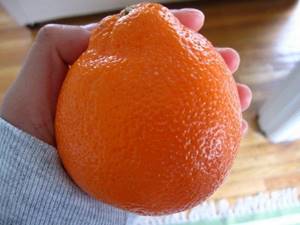
Meanwhile, it originates from Duncan grapefruit crossed with Dancy mandarin. A hybrid of these fruits, called mineola (from the English Minneola), was bred by breeders from the United States of America in the 30s of the 20th century. Its taste and aesthetic qualities were highly appreciated by experts and soon the new citrus began to be cultivated not only in the USA, but also outside its homeland - in Israel, Turkey, and China.
What does the fruit look like?
Externally, the Mineola fruit is more similar to an orange than to its parents - tangerine and grapefruit. True, from the grapefruit it got its large size (about 8 centimeters in diameter), and from the tangerine it got the bright color of the peel (deep orange, close to red). The rather dense peel is not particularly thick and can be easily removed, almost like a tangerine.
Among other citrus fruits, mineola is distinguished by a semicircular thickening at the top of the fruit, approximately 1 centimeter high (sometimes a little more).
The color of the mineola pulp is lighter than the color of the peel - light orange with a distinct yellowish tint. The cut fruit looks very attractive and smells wonderful of citrus.
Taste qualities
As for the taste of Mineola, it has something of the fruit on the basis of which this hybrid was bred, but still it is not a tangerine or a grapefruit. The sweet pulp of this fruit is very juicy - several times juicier than tangerine. The piquant bitterness of grapefruit is completely unnoticeable in the taste of Mineola.
Each slice is surrounded by a thin film - much thinner than that of the original fruit. As soon as you take a slight bite, your mouth is filled with wonderful sweet juice with a slightly noticeable pleasant sourness.
Description
Minneola is an evergreen tree that grows in a subtropical climate, like its ancestors. Plants of this species are bushy, with a spreading crown and a large number of fruits. Young seedlings have a green tint to the bark, which turns brown as the tree matures. In a favorable climate, the trunk height reaches 4-5 meters. Houseplant lovers often grow citrus trees on the windowsill. Under these conditions, trees grow no more than 1.5 m.
Mineola leaves are elongated, large, bright green. During the flowering period the trees are very beautiful. Small milky buds with five narrow long petals bloom on the branches. At this time, the flowers exude a delicate aroma. On mature trees, the buds form multiple inflorescences. The plants are self-pollinating, but to increase the size of the fruits you need to tie them.

In appearance, Mineola fruits are more reminiscent of oranges than tangerines. Thanks to the presence of grapefruit genes, they are quite large - up to 8 cm in diameter. The peel is dense to the touch, but not particularly thick. The skin color is rich, orange, with the addition of a reddish tint. A distinctive feature of mineola is that at the top there is a thickening about a centimeter high, forming a hemisphere. Because of this, the shape of the fruit is slightly similar to a bell.
When cutting the fruit, a thick, characteristic citrus aroma is felt. The pulp has a juicy yellow-orange color. Taste qualities are borrowed from both parent species: the pleasant sweetness of tangerine is combined with the slight sourness of grapefruit. Thanks to the dense peel, the fruit is well preserved and can withstand long journeys. Another advantage of the hybrid is its unpretentiousness. Trees adapt well to colder climates than in their homeland.
Composition, calorie content, nutritional value
Mineola pulp is considered a valuable dietary product that can be consumed when losing weight (of course, in reasonable quantities). It is almost completely free of fats and proteins, and carbohydrates are contained in very limited quantities (up to 9 grams per 100 grams of the product itself). True, due to the fact that they are fast carbohydrates, their consumption can increase appetite.
Mineola pulp also contains a lot of water - as much as 85 grams per 100 grams of weight. In general, the calorie content of this fruit is very low: 100 grams of pulp contains only 40 kilocalories. If we consider that the mass of an average-sized mineola is 300-350 grams, it is easy to calculate that one fruit contains from 120 to 150 kilocalories.
Chemical composition and calorie content
Scientists analyzed the nutritional value of the citrus fruit Mineola; the calorie content of 100 g is 47 units. The hybrid consists of water (86.75%) and fiber, which is several times more than in sweetie or pomelo.
The fruit should be consumed in moderation, because... Fast carbohydrates increase appetite.
The fruits contain vitamins A, C and B. To improve health, doctors recommend regularly consuming a product such as mineola: the composition of the healthy fruit is distinguished by a large number of microelements necessary for health.

The exotic fruit contains:
- calcium;
- lutein;
- antioxidants;
- beta-carotene;
- xanthine;
- folic acid.
Plant fiber and organic acids improve health. Many toxic compounds are removed from the body by a hybrid such as Mineola; the chemical composition helps prevent cell aging and prevents the development of pathological processes.
Consumers are interested in the caloric content of a mixture of orange and grapefruit. The product is used for dietary nutrition, strengthening the body's defenses, and cleansing the circulatory system. People who use the diet prefer mineola; they receive calories in the amount of 2% of the daily value. The hybrid contains proteins - 0.41 g, carbohydrates - 9.70 g.
Unsaturated fat in 1 serving (1 piece) is 0.05 g. The weight of the Minneola Nova fruit does not exceed 110 g, the amount of water is 85.9 g. The peel of the exotic fruit contains essential oils, and the white peel is a source of plant and ballast components.
1 fruit of the Lining variety contains 50 kcal, 11 g of carbohydrates and 1 g of protein. The Tangerine medium type has less calories (45 units), the composition of proteins, fats and carbohydrates is expressed in the proportion: 3:0:1. The Sherries fruit weighs 156 g and contains 100 kcal, while the hybrids Mineola Orange, Sections, Fresh have only 15 kcal per 100 g of product.
We recommend that you familiarize yourself with the BJU of grapefruit and its glycemic index
Beneficial features
Mineola pulp contains the same beneficial substances as other citrus fruits, so it can be an excellent replacement for traditional tangerines or oranges.
Thus, ascorbic and folic acids, which this fruit is rich in, help improve metabolic processes, strengthen the immune system and increase the activity of neuron cells, normalize hormonal levels and improve concentration.
Water, fiber and fructose, present in large quantities in the pulp of mineola, are beneficial for the digestive system. Water helps remove toxic substances from the body and saturate cells with moisture, while fiber helps to naturally cleanse the intestines and more fully absorb nutrients. Fructose is a natural sugar substitute that is easily absorbed by the human body.
Mineola is rich in iron and magnesium, which are needed for hematopoiesis, as well as potassium, necessary for the normal functioning of the heart and brain, and calcium, which strengthens muscles, teeth and bones.
Currently reading: Unusual fruit - finger citron
And, of course, the very process of cleansing and leisurely eating the juicy and sweet fruits of the mineola calms and puts you in a positive mood, which means it has a beneficial effect on the nervous system.
Mignola fruit what is it - Cottage, garden, vegetable garden, indoor plants
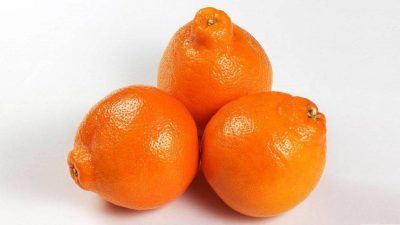
The Mineola fruit is a citrus fruit. It was obtained by crossing an orange and a tangerine. And yes, this is what we consider a tangerine with a bunch of seeds, a glossy orange or an overgrown tangerine. In stores, next to mineola there is often the inscription “tangerine”.
Although it even looks different from Abkhazian tangerines. The fruits are larger, with a glossy skin. Its color is bright orange. Often the mineola is torn off with its green leaves and placed on the shelves in this form.
The fruit “inherits” the beneficial properties of tangerine and orange.
articles:
Benefits of Mineola
In our age of total struggle against carbohydrates, it is somehow awkward to talk about this, but the fruit is useful precisely because of the combination of simple carbohydrates from fructose and a large amount of fiber. Fructose feeds our brain and muscles with useful energy.
And fiber prevents this energy from being absorbed too quickly and “hitting the head” of the person who ate the fruit. Mineola is an ideal snack for physically active people, for those who want to lose weight by increasing physical activity, and for athletes.
One fruit will not contain more than 14 g of carbohydrates, which is the minimum value. This means that a couple of fruits can be included in the diet on the most strict diet.
Mineola is sweet and tasty, which allows it to be eaten even by those who, in principle, do not really like fruits and would prefer to “fill up” their entire calorie intake with marshmallows or chocolate. Fructose is a real natural energy drink. If it’s been a long time since lunch, and you need to go to training, eat a couple of fruits with some low-fat source of protein (the same egg whites, or low-fat cottage cheese or chicken breasts), and you can work out your workout on the rise, and not gain any extra calories. before it, nor after it.
The fruit is rich in vitamin C. We are accustomed to underestimating ascorbic acid, but it is one of the most important vitamins for both human immunity and for the restoration of tissues after exercise.
It is recommended to increase our intake of vitamin C when we are trying to lose weight and restricting caloric intake. In addition, vitamin C has antioxidant properties, it helps rejuvenate the body and accelerate metabolic processes.
Thus, fruits help not only to diversify your diet, but also to avoid diseases associated with calorie deficit and overload.
Mineola is a source of carotenoids. They give our skin a nice tan color when we come into contact with the sun. Therefore, if you decide to tan on vacation, or go to a solarium, Mineola will be an excellent addition to your diet. In addition, carotenoids are good for improving vision and supporting anabolic processes in tissues after exercise.
Mineola is rich in fiber of different types - soluble, insoluble. It improves digestion, helps relieve constipation and intestinal pain, and helps to better absorb nutrients and vitamins.
Fruit acids in the product improve digestion and secretion of gastric juice. They also allow you to speed up the passage of the food bolus through the gastrointestinal tract. they are not as high in this fruit as in lemon and grapefruit, so you don’t have to worry about acid reflux after eating a couple of fruits.
Mineola is a source of essential oils. Not only do they help improve your mood, but they can also be a means of “eliminating” pathogenic bacteria in the air. Essential oils in an aroma lamp are an excellent means of prevention during the cold season. You can simply carry a mineola crust with you and smell it, or you can sprinkle a little oil on a napkin and carry it in a closed bag.
Mineola oil is also used as an ingredient in various warming compositions against cellulite, to eliminate excess fat deposits and improve blood circulation. You need to understand that this remedy is effective not due to the fact that it somehow burns fat, but only as a “blood circulation accelerator.” Mineola oil allows us to avoid problems with slow blood circulation and has a warming effect. But it does not change metabolism and is not a “fat burner.”
Mineola in cooking
Like other citrus fruits, mineola is widely used in cooking. Usually it replaces tangerines, oranges and other sweet citruses included in any dish. However, there are many recipes where the main ingredient is mineola.
How to eat mineola
Despite the fact that most often Mineola is eaten fresh, having previously been peeled and seeded, residents of different countries around the world have found their own ways of consuming this fruit. Eg:
- Americans enjoy freshly squeezed juice from Mineola fruits;
- Chinese residents prefer to add it to salads and rice dishes;
- In Bulgaria, the whole fruit is used - the fresh, juicy pulp is eaten for dessert, fragrant jam is made from the skin, and the oil extracted from it is used as a flavoring for alcoholic drinks.
Recipes
As mentioned above, mineola can be eaten not only fresh, but also used to prepare various dishes:
- pies;
- cheesecakes;
- salads;
- jam;
- smoothie.
Try to prepare several simple but very original dishes, each of which contains Mineola. You will definitely like them!
Salad
To prepare fruit salad with mineola you will need:
- ripe peach;
- 100 grams of ripe pineapple (can be replaced with canned one);
- sweet crumbly apple;
- mineola.

Wash all the fruits, peel and pit them, cut into small cubes and mix thoroughly. Place the salad in bowls and top with either yogurt or whipped cream. If you wish, you can garnish the salad with pomegranate seeds and a sprig of mint before serving.
Pie
To make mineola pie you will need:
- one and a half glasses of premium wheat flour;
- a glass of Mineola juice;
- a glass of sugar;
- 100 milliliters of vegetable oil;
- lemon and lemon zest;
- mineola;
- soda.
Knead the dough from flour, juice, vegetable oil and sugar, add soda and lemon zest to it. Pour into the mold and place in an oven preheated to 250 degrees. Bake until done. While the dough is in the oven, prepare the filling. To do this, cut the lemon and mineola into pieces, remembering to carefully remove the seeds, and grind in a blender. Add a little sugar to taste. When the dough is baked, remove it from the mold and cut into two layers. Divide into two parts and fill. Cover the first layer with half the filling, cover with the second layer and also place the filling on top. Decorate the pie with slices of mineola, clearing them of membranes.
What to cook from mineola?
The juice is added to vitamin smoothies and fresh juices. The peel is used in tea and soft drinks. The pulp is good fresh. It is used in salads or eaten separately.
Mineola goes well with mint. It will be a good substitute for lime when making non-alcoholic mojito or lemonade. The drink tones and energizes.
Cheesecake with mineola
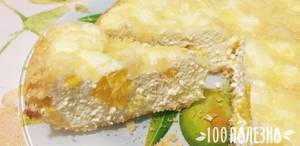
This is a gluten-free version of cheese pie that is easy to make at home. It will surprise you with unexpected notes and delight you with bright colors. Instead of store-bought cookies, I use homemade butter crumbles. It turns out even better than the original recipe. I also have soft grains on top, like in spinach pie.
Ingredients:
- 0.5 packs of margarine or butter.
- Cottage cheese – 2 packs (any fat content).
- Hard cheese – 100 g.
- Corn flour - half a glass.
- Mineola – 2 pcs.
- Eggs – 3 pcs.
Preparation:
- Mash cottage cheese with eggs and grated cheese.
- Wash the Mineola, peel it, free the pulp from the films.
- Add to the curd mixture, stirring gently with a spoon.
- Prepare butter crumbs. To do this, rub the soft fat and flour with your hands (or chop with a knife, as in “Napoleon”).
- Place a layer of crumbs on the bottom of the multicooker bowl.
- Pour out the mass.
- Sprinkle crumbs on top.
- Turn on the “Baking” mode.
- At the end of the program, open the lid and cool slightly.
- Place on a plate.
Fruit salad
For the vitamin dessert you will need:
- ripe banana,
- mineola,
- seeds of half a pomegranate,
- two sprigs of mint,
- half an apple
- dried apricots – 3 pcs.,
- ripe pear,
- feijoa with sugar or cranberries for topping.
What to do:
- Peel the banana. Divide into 1 cm circles.
- Wash the mineola. Free the fruit pulp from skins and films.
- Remove the seeds from the pomegranate. The 100polezno blog has a separate article on how to clean it properly.
- Wash and dry the mint. Tear off the leaves.
- Cut the peeled apple and pear into slices.
- Rinse the dried apricots thoroughly and soak in cold water for half an hour. Rinse and let the water drain.
- Mix the ingredients.
- When serving, garnish with cold jam.
Dessert
Cheesecake made from cottage cheese and mineola
Take 400 grams of full-fat cottage cheese, 350 grams of sugar cookies, 6 large mineola fruits, a bag of gelatin, sugar and a glass of whipped cream. Finely grate the cookies. Mix it with a small amount of whipped cream to achieve a dense, but at the same time, plastic consistency. Place it on the bottom of the plastic mold in an even layer. Mix the remaining cream with the cottage cheese, beat in a blender, then place the resulting mixture on top of the cookies in the mold and place in the refrigerator for half an hour.
Dissolve gelatin in water. Squeeze the juice from three mineolas and mix with gelatin. Cut the remaining fruit into slices and place on top of the cottage cheese. All that remains is to pour the prepared mixture over the cheesecake and put it in the refrigerator. After hardening for two hours, the finished dish can be served.
Mineola jelly
Cut 3-4 mineola fruits in half, carefully remove the pulp, leaving the peel intact. Squeeze the juice out of the pulp, mix it with gelatin dissolved in water, heat until the lumps are completely dissolved.

Add granulated sugar to taste, let cool slightly and pour this mixture into the empty peel halves. Place in the refrigerator until completely set. Before serving, cut each cup into two parts and garnish with a mint leaf.
Exotic cocktail with Mineola
Take 2 mineolas, a piece of watermelon, 2 kiwis and a papaya. Extract the pulp from the papaya. Peel and pit the remaining fruits and cut into slices. Place everything in a blender, add coconut milk (choose the amount to taste - the less, the denser the consistency will be), add 3 ice cubes. Beat thoroughly until a homogeneous mass is formed. Pour into glasses and garnish with a slice of kiwi.
Currently reading: What are the advantages of Abkhazian tangerines, how to choose delicious and seedless ones
There are many great recipes online that use mineola. You will definitely like many of them!
How to choose a tasty fruit
Fully ripe Mineola fruits are considered the healthiest and tastiest. How to choose the “right” fruit, not sour or overripe, in order to get maximum pleasure?
Fortunately, this is not difficult. Try to remember the signs of a high-quality fruit and, if necessary, put them into practice. So, what should a juicy ripe mineola be like?
Quite dense and elastic. If the fruit is difficult to press, it is clearly not ripe. If, in addition, the skin of the fruit you have chosen is lighter than that of the fruits lying nearby, it still has time to ripen.
Buying an overripe fruit will not make you happy either. If its peel seems suspiciously soft to you, gently press it. Surely there will be a clearly visible depression on it. This sign indicates that the fruit is very overripe and is not suitable for food.
Carefully inspect the fruit from all sides. The presence of damage and stains on the peel indicates careless transportation or improper storage. At the same time, the bumps, unevenness and slightly dried areas that often dot the surface of most fruits are purely “cosmetic” defects that do not in any way affect their quality.
History of origin and habitat
The hybrid is obtained by crossing Dancy mandarin and Duncan grapefruit. The work was carried out by Dr. W. Swingle in Florida. In 1898, a similar crossing was carried out by G. Webber in California. A mix of Bowen and Dancy mandarin, this is a flattened, weak-necked fruit grown commercially in California home gardens.
Orlando grows in sandy soils in Florida. Ugli is an accidental hybrid, obtained by Dr. W. P. Betters in 1947. The fruit is grown in South Africa and New Zealand.
Alamoen is a fruit similar to Ugli. First discovered by Dr. B. Rahrer in Suriname. The seeds were collected and planted in Rio Chico, a department of Argentina. Dr. Faychild planted several trees in Miami.
We recommend that you read the beneficial properties of kumquat for women
The hybrid is grown on an industrial scale in Israel. Fruit trees can be seen in Jerusalem, Netanya, Beit She'an and Arad. Many fruits are harvested in the Arava Valley on the border with Jordan. Fruit trees grow in Kiryat Bialik, a suburb of Haifa.
How to grow mineola at home
Like other citrus plants, Mineola grows and bears fruit well in a city apartment. You can grow it yourself, from seeds taken from a ripe fruit. The fresher the seeds are, the sooner they will germinate, so if you seriously decide to grow mineola, we advise you to first prepare glasses with soil, and only then start tasting the fruit.

The best time of year to germinate mineola is early spring. You will need a nutritious soil mixture, filled with humus and sufficiently loose from the sand it contains. The seeds removed from the pulp of the fruit are immediately, without allowing them to dry out, buried in the soil by one phalanx of a finger, poured over the edge of the glasses with warm rainwater with a few drops of aloe juice, covered with glass and placed in a warm place, away from bright sunlight.
For successful germination, Mineola seeds need high temperatures - not lower than +25°C - and moist, but not waterlogged, soil. The glass from the glasses is removed daily and wiped from condensation, then returned to its place. If the surface of the soil turns out to be dry, carefully moisten it with a spray bottle. The appearance of sprouts should be expected within two weeks to one month. The fresher the seeds were planted, the faster they will germinate. Sometimes, under particularly favorable conditions, seedlings may appear after 10 days.
After successful seed germination, the glass is removed, the glasses with small mineolas are transferred to a well-lit place and cared for in the same way as other plants in the house: they are regularly watered with rain or heated melt water, the glasses are turned 90° daily so that the stems do not bend, they are monitored to ensure that there are no drafts and the room temperature does not drop below +20°C.
When 4-5 leaves are formed on each plant, the mineolas should be transplanted into larger containers - either plastic glasses with a volume of at least 0.5 liters, or small pots - and continue to care for them. In autumn, grown-up mineolas need to organize a rest period: lower the temperature to +18°C and reduce watering, preventing the soil from completely drying out. At the end of February - beginning of March, the temperature is increased, watering is gradually increased and they begin to feed with nitrogen and mineral fertilizers, alternating them.
Currently reading: Blood orange: where is it used?
To create conditions close to natural for young mineolas, you need to take care of humidifying the air: spray them with a spray bottle, install an air humidifier or at least a spacious aquarium in the room where they are located. In winter, when the central heating radiators radiate heat, and the air in the apartment becomes too dry even for our own skin, pots with plants need to be moved to a room with high humidity - for example, to the bathroom - and regularly, at least 2-3 times per day, spray. If you do not do this, the mineolas will begin to lose leaves and may die.
By the way, any changes that occur in the foliage of mineolas indicate that something is wrong with the plants. These evergreen trees normally lose their leaves little by little and very rarely. Massive yellowing and heavy leaf fall can be signs of serious mistakes in care: lack of sunlight, too little or, on the contrary, too much watering, which often leads to rotting of the roots, deficiency of nitrogen fertilizers or lack of potassium.
Another reason for the sudden yellowing of leaves is a flowerpot that has become cramped. In this case, only immediate transplantation will help.
Description of the plant
Since its appearance and properties can vary significantly, we will describe the “Florida” version as the closest to the required standards.
The tree is tall, in open ground it can reach 4 meters or even more. In indoor conditions - up to 2 meters, with good care. The branches are completely free of thorns. The branches themselves are strong, with light, rough bark, and form a compact crown.
The leaves are narrow-elongated, hard, sitting on large, long lionfish. The degree of foliage is high, it depends on the illumination and the amount of moisture. The plant is relatively frost-resistant and can withstand short-term temperature drops below zero degrees.
Bloom
The flowering pattern is similar to tangerine. This means that the tree blooms profusely, usually in the second half of spring, but a second wave may occur in the summer. In its intensity it is significantly inferior to the first. The flowers are small, fragrant, and the petals are pure white.
Citrus growers note that often a significant part of the flowers fall off without setting fruit. This is especially noticeable when kept indoors. The reason is that Mineola has poorly developed self-pollination. For a good harvest, you need a tree of a different variety, or even the same one, growing nearby, but not its clone (biological twin).
It has also been noted that in potted culture, fruit set prevents the emergence of new growth on the branches. In years when fruits develop well, the crown practically does not increase. On the contrary, if a good growth of new shoots begins in the spring, the harvest will be meager.
Description of fruit
Its fruits brought glory to Mineola. They have a delicate, refined, sweetish-sour taste. Some people claim that it looks like a mixture of orange and tangerine. The orange-colored pulp consists of 10 - 12 segments and literally melts in your mouth.
Interesting! These fruits are a real champion in folic acid content. In particular, it is called a “women’s vitamin”; it is very useful for pregnant women, because it prevents the occurrence of congenital defects in the child.
— The color of the peel is bright orange. If you keep the fruit on the tree, the color becomes pale.
— The aroma is strong, the surface structure is smooth, the essential oil pores are almost invisible on it.
— Peel of medium thickness. An important feature, unsuccessful from the point of view of commercial qualities, is its weak adherence to the pulp.
— The shape is elongated, about 8.5 cm long. The width is 1 - 1.5 cm less.
Enthusiasts of indoor citrus growing consider Mineola to be an excellent highly decorative tree. However, it has an important drawback: it is difficult to achieve significant yields, and ripening fruits often turn out to be overly sour.
Since its appearance and properties can vary significantly, we will describe the “Florida” version as the closest to the required standards.
Harm and contraindications
Like all citrus fruits, not everyone can eat mineola.
For example, due to its high acid content, this fruit is contraindicated for stomach ulcers or intestinal problems, especially during an exacerbation.
You cannot eat mineola if you have diabetes.
Mineola is also contraindicated for people prone to allergies to citrus fruits. If you or your child, after eating tangerines or oranges, develop skin rashes and other signs of allergies (nausea, dizziness, profuse nasal discharge, the skin becomes covered with flaky red spots), it is logical to assume that mineola can cause a similar reaction.
Young children who have already tried other citrus fruits can be offered one or two slices of Mineola. If the introduction to the new fruit is successful, next time you can give the whole fruit, previously peeled and seeds removed, but not more than 1-2 times a week.
Mineola for weight loss
The fruits of the citrus plant are low in calories, so they are used for weight loss while on a diet. Benefits of introducing Mineola into the diet:
- pleasant taste, making losing weight easier and more enjoyable;
- energy reserve: prevents lethargy and drowsiness;
- saturation from fiber, will be tolerated better during fasting;
- moisture in large quantities, filling the stomach to dull hunger;
- Citrus contains essential natural oils that increase tone and vigor throughout the day.
This fruit is not a universal fat burner. The fiber contained in the composition cleanses the intestines and makes you feel full, but for a while. If the calorie content is low, you need to remember the fructose in the pulp. If active weight loss occurs, you need to reduce the consumption of the product in your diet.

To quickly lose extra pounds, it is not recommended to exceed the daily intake of fruit. Simple carbohydrates trigger the active production of insulin, which stops the fat burning process.
This sunny fruit has restrictions on consumption. Citrus contains many acids that affect the gastrointestinal tract and the risk of stomach ulcers. If a person begins the acute stage, Mineol is not recommended for use. Diabetics will also not be able to enjoy the taste of citrus due to acids and sugar.
A large amount of citrus consumption leads to allergies. Common symptoms include redness on the face or skin of the hands, fever, rashes, and upset stomach. Therefore, children under 7 years of age can be given only a few slices per day in the absence of allergies.

